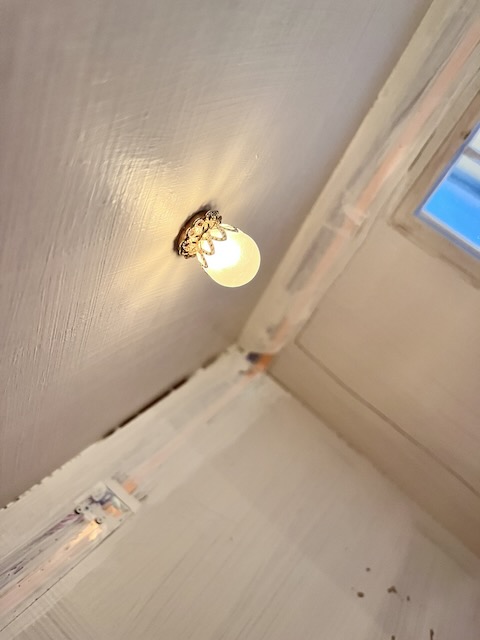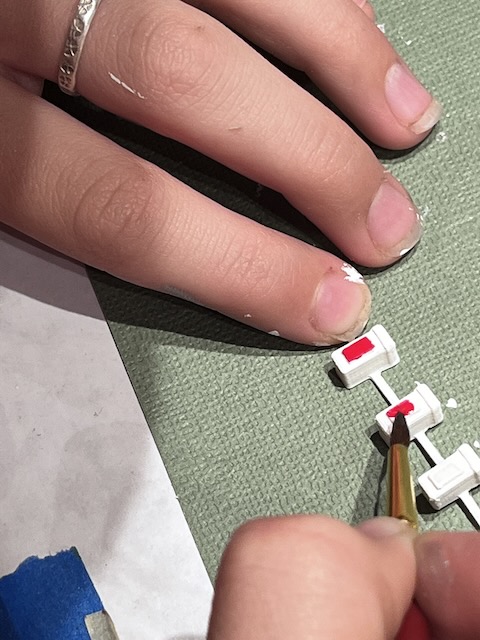I tend to say, "Life gets in the way," when I don't work on minis, but that is only a half truth. Sometimes I just lose momentum, especially when I'm facing tedious tasks in the dollhouse. This week, the mood to mini returned, nearly obsessively. I am ready to have the Manchester finished. Worried that the house wasn't turning out the way I wanted it to or that some of the workmanship isn't exact, I think fueled such a long hiatus. This last week, though, with most my obligations competed, I dug in and made great progress. In addition, I've not been able to commit to wallpaper, lighting, even a bathroom sink, even though I had purchased two Shapeways sinks. Here's what I've accomplished.
Electrifying a dollhouse might be the worst project, second to maybe roofing with individual shingles. Mitering crown molding also tends to bring on procrastination. Following Sue Conlin @ sussmallobsessession, reminded me of some of the cutting techniques for crown molding and some electrical tricks that I had used in the Pink Farmhouse, giving me confidence to continue on.
I've made my own lights since the beginning using beads and beading findings. I took my first lessons from Cinderella Moments, following her chandelier tutorial. I made several, with fair results. Wall sconces were inspired by the various tutorial I found on Pinterest.
I make lighted wall sconces using beading supplies from Bindles Ornaments, a Dutch company with a wonderful selection of high quality beading supplies with tutorials and kits. Their kits might be a bit more advanced for the beginners, but they are a great way to learn how to create your lighting fixtures.
You will find the information for my tutorial for the bathroom sconces at Make Something Pretty. The foundation for the sconce came from Bindles, but when I checked their catalog today, this piece doesn't seem to be available, but there are other pieces that might work.
Bindles is a lovely company to work with: great service, beautiful products, great instructions, and most importantly, quality products. The only drawback that I can find is the delivery time since they are overseas. Beginners might do well to shop local craft stores that sell beading supplies, such as what I used for this little light. Once you begin buying beading supplies and tools, you build up a stash that will make it easy to make all kinds of lamps, sconces, and ceiling lights. You can also find beading supplies online.
The supplies are simple. I purchase the little lights from Cir-Kit Concepts, but other miniature suppliers offer the same lights. Check prices and shipping. I like this company because they offer such great support. I ruined an expensive chandelier that I purchased from them and shipped to them for repair.
I always use glue made just for beading because it won't cloud the beads or glass globes like white glue tends to do. I ordered the frosted replacement globe from Just Miniatures and they can also be purchased from Factory Direct. For the clear bulbs, I purchase glass globe findings at Hobby Lobby, or anyplace else, including Etsy. The assembly is quite simple string the findings on the lighting wire, using a toothpick to apply tiny dabs of glue between each layer, being careful not get glue in the wiring.
And there you have it. I originally this style for the wall sconce above the bathroom vanity.
But found that it was too small. I work out my wall design on the work counter laying flat then photograph the arrangement so that I can see what it might look like.
I ended up installing this light on the ceiling in the bedroom above the canopy bed. It's perfect for the spot.
Installing the wall sconces was easy, once using Susan's technique.
To begin, I printed my wallpaper on mat photo paper and sealed it with Krylon. I measured the location for each sconce then punched small holes to feed the wires to the back of the paper and used dabs of the beading glue to attach the sconces to the paper (purchased from Lovely Minis Designs on Etsy).
Because the paper is downloaded and printed, I work with a prin-outt on computer paper first to test size and placement.
Ordinary scotch tape holds the wires in place on the back of the wallpaper. The photo paper is heavy enough that the wires won't show through the paper, but if you use a lighter weight paper, mount it on card stock to reinforce to print and to prevent the wiring from showing through the wallpaper. Since I had the wires on the back of the wallpaper, I applied the wallpaper adhesive (Grandmother Stover's) to the wall.
I run my copper tape wire across the floor, then run the sconce wires down the wall behind the wallpaper and across the floor to copper wiring. This technique works only if the sconce wires are long enough, which mine barely are.
Making wall sconces and ceiling fixtures allows for more creative, distinctive lighting at a reduces cost once you have created a stash of beads and beading supplies, including the specialized beading tools. Here's another light that I have decided where to put just to demonstrate how easy it is create your own lights:
Tools:A drill. I most often use my Dremel. Because of its length, I have to drill the hole at an angle, but that really doesn't matter. Sometimes I use tool that came with my Cir-Kit wiring kits that has both an awl point and two drill bits. I use Cir-Kit's awl to make the pilot hole for the eyelet; insert the eyelet with the black awl, use the allgatory clamp type tool to strip the insulation from the wiring, a small hammer to pound the eyelets in place, and scissors--just in case.
With the wires secured in place, I cover them tape: blue painter's, scotch, or even electrical. I've used all three through out the house. Covering the wires with tape will secure them in place and add some protection once the floors are in place.
This wall is now ready to decorate. I'll add the vanity, sinks, toilet, and shower.
Next for the kitchen hanging lights. Lighting the Way post shows how I created the glass pendent lights There's one thing that I didn't include, how to hand the lights. Commercially lighting has all the component for hanging and attaching these types of light, but handmade lighting requires a bit of creative thinking. I needed to be able to attach the chain that suspends the light and attaching the electrical wire to power. The wire is fed through a hole in the ceiling then attached to the copper tape wire.
I used a Dremel drill to drill the holes, but a thumb screwdriver works well, too.
The pendent chain is attached with a jump ring to a head pin with the loop used in beading. I thread the head pin through same hole the hole in the ceiling. If you have difficulty pushing the electrical wire through the hole, I thread my wires on a needle with a large eye (but not too large to go through the hole.)
Now you are ready to attach the wires to power.
I used bulbs with black insulation for the kitchen and white for the dining room chandelier, hand made using a Bindle's kit.
Here you can see the head pin. I didn't trim mine back, tapping in place instead.
Here's a tip I learned from a Cir-Kit tutorial. There are two ways to strip away insulation on wiring: a) use your thumb nail, which works well for the tiny rice bulbs since the wiring is so small. If you have strong nails, a thumb nail will effectively strip the insulation away; b) use an alligator-like clip too that you can order from Cir-Kit--an invaluable tool.
For light with ample wires, I'll strip away plenty of insulation, but not clear to the end. With some insulation still attached, I have a handle to twist the wiring around the eyelet. But pull too hard on the clamp and the entire wire is stripped or worse the wire breaks, which could be disastrous on short wires.
Always work on wiring with the electrical source unplugged to avoid shorting out your electrical system. Before I pound the eyelet into place I plug in the power to make sure I have a good connection and the light works. I also test all of my bulbs before I use them to make sure they work.
Insulation tail as a handle or a pair of needle nosed tweezers used to wrap the tiny wires around the eyelet make this chore easier.
Yes I know that bathroom wall is crooked. That's the next project. I'll repeat the process with a Houseworks double sconce from my stash on the bedroom side and wall art on the bathroom side. That's my project for later today.
And now two stories are lighted. The gabled rooms will be fun to add light to, won't they? Stay tuned.

















.jpeg)






















.jpeg)
.jpeg)
.jpeg)

.jpeg)











